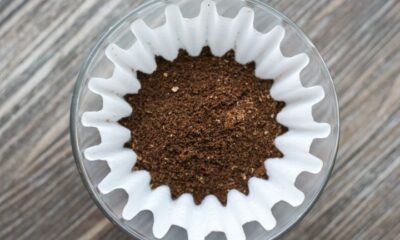NEWS
25 Civil War-Era Survival Foods Preppers Can Still Make Today
Published
3 days agoon

Shutterstock
The Civil War era was a time of resourcefulness and survival, where people had to rely on simple, accessible foods that could be preserved and prepared with limited supplies. Many of these recipes are still valuable today, offering preppers and history enthusiasts timeless methods of sustenance. From hardtack to jerky, these dishes provide insight into how people endured tough times.
Hardtack

Shutterstock
Hardtack is a simple cracker made from flour, water, and salt, designed to last for months or even years when stored properly. It was a staple for soldiers due to its durability and ease of transport. Though bland, it can be softened by soaking in water or soup, making it versatile in survival situations. Hardtack remains a practical food for preppers looking for long-lasting sustenance.
Salt Pork

Shutterstock
Salt pork was a common protein source for Civil War soldiers, cured with salt to extend its shelf life. This preserved meat could be fried, boiled, or added to stews to enhance flavor and nutrition. Its high-fat content provided much-needed calories for those on the move. Today, salt pork can be prepared easily at home using similar curing methods.
Cornbread

Shutterstock
Cornbread was a beloved food of the era, made from cornmeal, water, and sometimes milk or eggs. Its ingredients were widely available, and it could be baked, fried, or cooked over an open fire. This versatile bread paired well with other foods like beans or stews. Modern preppers can make cornbread to enjoy its quick preparation and satisfying taste.
Dried Beans

Shutterstock
Dried beans were a key source of protein and fiber for Civil War soldiers and civilians alike. They could be stored for long periods without spoiling, making them ideal for survival situations. Beans were often boiled and combined with other ingredients like salt pork or vegetables. Today, dried beans are a must-have for any prepper’s pantry due to their nutritional value and longevity.
Pemmican

Shutterstock
Pemmican is a traditional food made from dried meat, fat, and sometimes berries, offering a concentrated source of energy. It was popular among soldiers and frontiersmen for its long shelf life and portability. This nutrient-dense food requires no refrigeration and can be eaten on the go. Preppers today can make pemmican as a reliable emergency ration.
Johnnycakes

Shutterstock
Johnnycakes, made from cornmeal, water, and salt, were an easy-to-prepare food during the Civil War. These flatbreads could be cooked on a griddle or over an open flame. Their simple ingredients made them accessible to soldiers and civilians alike. Preppers can recreate this historical recipe for a quick and filling meal.
Bacon Rind Soup

Shutterstock
Bacon rind soup utilized scraps and leftovers, demonstrating the resourcefulness of the time. The rinds were boiled to extract flavor, often combined with vegetables or beans. This soup provided warmth and sustenance, especially during cold months. Modern preppers can adopt this practice to make the most of every ingredient.
Molasses Candy

Shutterstock
Molasses candy was a rare sweet treat during the Civil War, made from boiling molasses until it hardened. It was easy to prepare with minimal ingredients and provided a morale boost for soldiers and families. This simple candy could also serve as an energy boost. Preppers can enjoy this nostalgic treat by recreating it in their own kitchens.
Vinegar Pie

Shutterstock
Vinegar pie was a creative dessert made when fresh fruits were unavailable. A mixture of vinegar, sugar, butter, and spices created a tart filling that mimicked the taste of lemon pie. This resourceful recipe highlights how households adapted to limited ingredients. It’s a fascinating dish preppers can replicate today to add variety to their survival menus.
Hominy

Shutterstock
Hominy is made from dried corn treated with an alkaline solution, which softens the kernels and enhances nutritional value. It was a versatile staple in the Civil War era, often eaten as a side dish or added to soups and stews. This traditional preparation method has stood the test of time. Preppers can make hominy as a durable and nutritious addition to their food supply.
Civil War Coffee Substitute

Shutterstock
When coffee supplies ran low during the Civil War, soldiers and civilians turned to roasted chicory root, corn, or acorns as substitutes. These alternatives provided a coffee-like beverage that boosted morale. Though not as rich as actual coffee, these substitutes were easy to prepare and widely available. Modern preppers can explore these alternatives as part of their emergency plans.
Dried Apples

Shutterstock
Dried apples were a popular snack and ingredient during the Civil War due to their long shelf life. Apples were sliced and dried in the sun or near a fire to remove moisture and prevent spoilage. They could be eaten as-is or rehydrated for use in pies and puddings. Preppers can easily prepare dried apples as a nutritious and portable food.
Firecakes

Shutterstock
Firecakes were made from flour and water, cooked on a flat rock or piece of metal over an open flame. This basic food was a last resort for soldiers with limited supplies. Though plain, firecakes were a lifesaver in dire situations. Preppers can replicate this simple recipe as a demonstration of survival ingenuity.
Potato Cakes

Shutterstock
Potato cakes were a common way to stretch a limited supply of potatoes during the Civil War. Grated or mashed potatoes were combined with flour and cooked on a griddle. This simple dish was filling and easy to prepare with minimal ingredients. Preppers can enjoy potato cakes as a budget-friendly survival food option.
Pickled Vegetables

Shutterstock
Pickling was a crucial preservation method during the Civil War, allowing vegetables to be stored for months without refrigeration. Cucumbers, onions, and cabbage were commonly pickled in vinegar and salt brine. These tangy treats added variety and nutrition to limited diets. Preppers can use pickling as a reliable way to extend the shelf life of fresh produce.
Cornmeal Mush

Shutterstock
Cornmeal mush, a porridge-like dish, was a staple food during the Civil War due to its simplicity and affordability. Made by boiling cornmeal in water or milk, it was often eaten plain or with molasses for added flavor. This filling dish could be served hot or allowed to cool and fried. Preppers can adopt this economical recipe for a hearty meal in tough times.
Bacon Fat Gravy

Shutterstock
Bacon fat gravy was a flavorful way to stretch scarce ingredients during the Civil War. Rendered bacon fat was combined with flour and water to create a rich, creamy sauce. This gravy was served over bread, potatoes, or biscuits to enhance the flavor of simple meals. Preppers can use this method to make the most of their resources while enjoying a touch of comfort.
Canned Peaches

Shutterstock
Canned peaches were a luxurious treat during the Civil War, often preserved in syrup for sweetness. Peaches were sliced, placed in jars, and sealed for long-term storage. This preservation method made them available year-round, even during harsh winters. Preppers today can can peaches for a delightful and nutrient-rich survival food.
Squirrel Stew

Shutterstock
Squirrel stew was a common dish for those living in rural areas during the Civil War. This hearty stew used squirrel meat along with vegetables and broth to create a filling meal. Hunting small game provided a sustainable protein source for families and soldiers. Preppers can adapt this recipe with locally available game or substitute with chicken.
Root Cellar Vegetables

Shutterstock
Root vegetables like carrots, potatoes, and turnips were stored in root cellars during the Civil War to keep them fresh. This simple storage method relied on cool, dark, and humid conditions to prevent spoilage. These vegetables served as a reliable food source throughout the year. Preppers can use root cellaring techniques to preserve their harvests without refrigeration.
Dried Pumpkin

Shutterstock
Pumpkin was often dried in thin slices to preserve it for later use during the Civil War. Once dried, it could be rehydrated for cooking in soups, stews, or pies. This method allowed families to enjoy the nutritional benefits of pumpkin long after the harvest. Preppers can replicate this practice to store pumpkin for emergency use.
Wild Foraged Greens

Shutterstock
Wild greens such as dandelion, lamb’s quarters, and chickweed were gathered and cooked during the Civil War. These nutrient-rich plants were freely available and added variety to limited diets. Greens were often boiled or sautéed and served as a side dish. Preppers can learn to forage for edible wild greens to supplement their food supply.
Jerky

Shutterstock
Jerky was a vital protein source for soldiers and pioneers during the Civil War, made by drying thin strips of meat. Seasoned with salt and sometimes spices, the meat was preserved without refrigeration and remained edible for months. This portable and durable food is a favorite among preppers today. Making jerky at home is a straightforward way to secure a reliable protein source.
Ashcakes

Shutterstock
Ashcakes were simple flatbreads made from cornmeal, water, and salt, cooked directly in the ashes of a fire. This technique required no cookware, making it convenient for soldiers on the move. Ashcakes were durable and filling, providing essential calories during tough times. Preppers can recreate ashcakes as a quick and easy survival food option.
Apple Cider Vinegar

Shutterstock
Apple cider vinegar was a multipurpose item during the Civil War, used for preserving food, cleaning, and even as a health tonic. Made by fermenting apple cider, it was a practical and affordable household staple. Vinegar was also used to pickle vegetables, extending their shelf life. Preppers can make apple cider vinegar at home as a versatile and valuable survival item.
Conclusion

Shutterstock
The foods and preservation techniques of the Civil War era offer timeless lessons in survival and resourcefulness. From simple breads to preserved meats and pickled vegetables, these methods ensured sustenance during difficult times. Modern preppers can draw inspiration from these historical practices to build resilient and practical food supplies. By embracing these techniques, you prepare not just for emergencies, but also connect with a resourceful past.
Related Topics:

More From Lifestylogy
-


23 Trends to Elevate Your 2025 Nail Appointments
-


20 Things People Mindlessly Spend Their Money On That Might…
-


23 Clever Coffee Filter Hacks That Go Beyond Brewing
-


25 Things In Your Home That Guests Might Secretly Judge
-


The Top 25 Health Benefits Of Owning A Dog
-


23 Advantages of Installing a Home Water Softener To Improve…
-


23 UGG Care Hacks for Lasting Comfort and Style
-


U.S. Anesthesia Partners Is Solving The Shortage Of Anesthesia Clinicians
-


23 Things Adult Men Should Not Be Caught Wearing